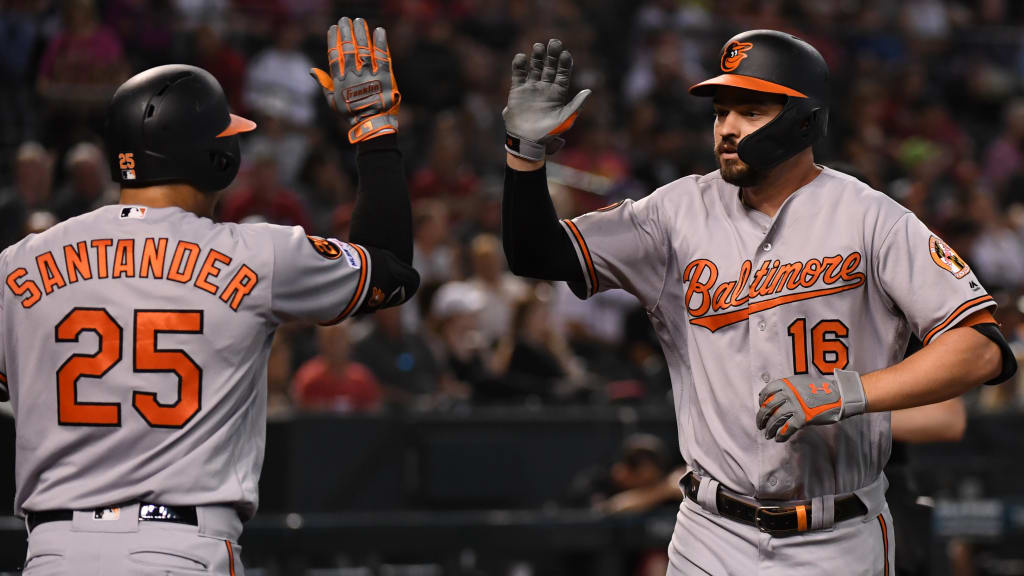
Throughout the Orioles' rebuilding process, general manager and executive vice president Mike Elias has consistently said he foresees the O's becoming a “transactional” team akin to the Rays and Indians, small-market clubs that rely on savvy moves rather than big budgets to regularly contend. That means trading players when their value is high, replenishing the farm system on a consistent basis and making transactions that can appear unpopular in the short term.
What does that mean for Baltimore's two most popular players? It’s a pertinent question to ask after Trey Mancini and Anthony Santander saw their names pop up in trade rumors this week, both via tweets from MLB Network insider Jon Heyman. Both have been billed by the Orioles as future cornerstones in recent years, budding stars the club could build around. So it was interesting to hear Elias categorically address the rumors on Wednesday, speaking on a Zoom call after the club signed free-agent shortstop Freddy Galvis.
“Everyone knows we’re listening right now,” Elias said. “We traded a number of veterans the last few years, and we’re pretty transparent about what we’re doing. I think if you’re a buying team right now, that puts us toward the top of the list. We have talented players, many of whom have years of contractual control left. It’s natural to get those phone calls. It doesn’t mean we’re going to do anything.”
Does that mean any deals are imminent? No. Rumors are just rumors, at least until they aren’t. Does it mean the Orioles are at least considering all their options? Yes. Should this come as a surprise? Probably not.
It’s not like they’ve been shy about trading veteran pieces for prospects with Elias at the helm, swinging deals for -- count them -- Andrew Cashner, Dylan Bundy, Jonathan Villar, Richard Bleier, Mychal Givens, Miguel Castro, Tommy Milone and José Iglesias over the past few years. That said, both Mancini and Santander profile differently. They are not aging veterans on expiring contracts, or role players whose on-field value to a rebuilding club is marginal. They are impact players who appear to be just entering their primes.
Which is exactly what makes them desirable to other clubs. How should the Orioles proceed? Here are the cases for and against trading either or both sluggers.
The case for
It’s not difficult to see why Mancini and Santander would be attractive to other teams.
After hitting 20 homers in 93 games in 2019, Santander broke out to hit .261/.315/.575 with 11 homers before a right oblique injury limited his '20 season to 37 games. He’s grown into a capable defender in right field, with a strong arm and the ability to play both corner positions if needed. Santander is a switch-hitter, 26 years old, and controllable through arbitration through '24. He will make either $2.1 million or $2.475 million, depending on arbitration, in '21. There is enough value there to yield not just a prospect or two, but potentially a bundle.
Mancini’s salary is locked in at $4.75 million for 2021 after missing all of last year undergoing treatment for Stage 3 colon cancer, with every indication he’ll be fully healthy for Spring Training. Mancini's breakout came in '19, when he hit .291 with 35 homers and 97 RBIs with an .899 OPS in his age-27 season. The fact that he’s under club control through '23 bolsters his trade value, assuming he soon alleviates any lingering health concerns.
The Orioles' case for trading either relates to their competitive timeline, which has arguably been slowed by the pandemic. 2021 marks Year 3 of Baltimore's rebuild, and while Elias has restocked the farm system considerably, it might not be ready to contend in earnest until '23 or even '24. That they’ve yet to approach Mancini about an extension, despite his public desire to remain in Baltimore, is telling with regards to their long-term plans.
The case against
The logical argument is simple: Since the rebuild began, the Orioles’ primary short-term goal has been to identify players to build their next contender around. Santander and Mancini both look like that type of player.
The emotional argument is more nuanced, relating to Mancini’s status as the face of the franchise and his inspiring story. He’s grown into a leader in the clubhouse and community, planting roots in Baltimore while reiterating his commitment to the city, time and time again. To put it mildly, trading Mancini would be a tough sell to a fanbase that’s endured more departures than additions in recent years, and one that has been forced to say goodbye to several popular players due to cost-cutting measures (Villar and Hanser Alberto among them).
Asked whether Mancini’s local stature would impact his trade value, Elias said, “What factors into our evaluation is that he’s one of the better hitters in baseball.
"He missed last year, which was a horrible surprise we all got in Spring Training. But we got him the best medical care on Earth. He took it on like Trey Mancini. He’s 100 percent. He’s looking great. We are super excited to see him in Sarasota. We think we’ll go right back to hitting in the middle of our lineup and being one of the better hitters in baseball this year.”
Elias then detailed the club’s plan to play Mancini primarily at first base going forward, due to Santander’s emergence in right and the interesting mix of young outfielders the O’s have both on the 40-man and high in their pipeline.
“He’ll be a big part of our team this year, obviously,” Elias said.



